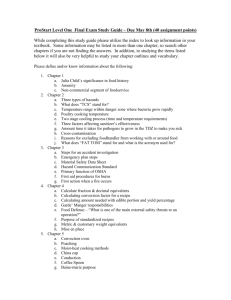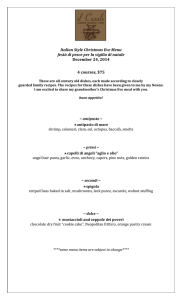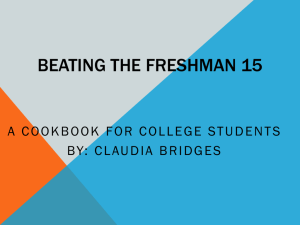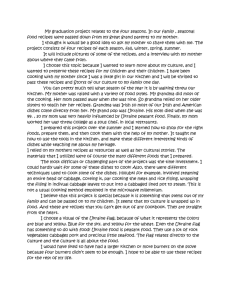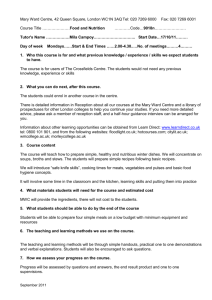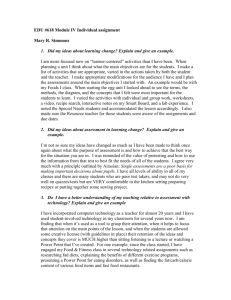KNIPPLE Q&A
advertisement
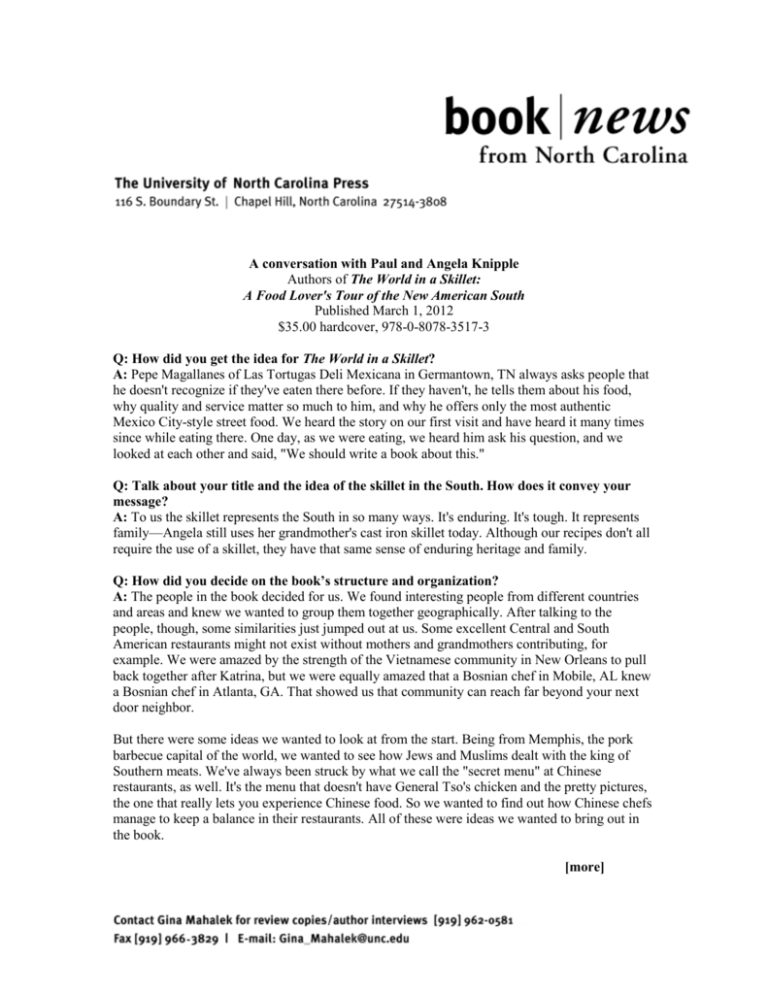
A conversation with Paul and Angela Knipple Authors of The World in a Skillet: A Food Lover's Tour of the New American South Published March 1, 2012 $35.00 hardcover, 978-0-8078-3517-3 Q: How did you get the idea for The World in a Skillet? A: Pepe Magallanes of Las Tortugas Deli Mexicana in Germantown, TN always asks people that he doesn't recognize if they've eaten there before. If they haven't, he tells them about his food, why quality and service matter so much to him, and why he offers only the most authentic Mexico City-style street food. We heard the story on our first visit and have heard it many times since while eating there. One day, as we were eating, we heard him ask his question, and we looked at each other and said, "We should write a book about this." Q: Talk about your title and the idea of the skillet in the South. How does it convey your message? A: To us the skillet represents the South in so many ways. It's enduring. It's tough. It represents family—Angela still uses her grandmother's cast iron skillet today. Although our recipes don't all require the use of a skillet, they have that same sense of enduring heritage and family. Q: How did you decide on the book’s structure and organization? A: The people in the book decided for us. We found interesting people from different countries and areas and knew we wanted to group them together geographically. After talking to the people, though, some similarities just jumped out at us. Some excellent Central and South American restaurants might not exist without mothers and grandmothers contributing, for example. We were amazed by the strength of the Vietnamese community in New Orleans to pull back together after Katrina, but we were equally amazed that a Bosnian chef in Mobile, AL knew a Bosnian chef in Atlanta, GA. That showed us that community can reach far beyond your next door neighbor. But there were some ideas we wanted to look at from the start. Being from Memphis, the pork barbecue capital of the world, we wanted to see how Jews and Muslims dealt with the king of Southern meats. We've always been struck by what we call the "secret menu" at Chinese restaurants, as well. It's the menu that doesn't have General Tso's chicken and the pretty pictures, the one that really lets you experience Chinese food. So we wanted to find out how Chinese chefs manage to keep a balance in their restaurants. All of these were ideas we wanted to bring out in the book. [more] 2-2-2 The World in a Skillet Q: What is distinctive about the South’s immigrant culinary culture? A: So many of the dishes we think of as being distinctly southern food are the result of the contributions and cultures of past immigrants. The contributions of enslaved Africans are at the heart of southern food. The French influence in Louisiana also created some of our favorite southern dishes. And then there are other things like German-influenced livermush and the mystery of the Mississippi Delta hot tamale. A lot of the immigrants we talked to are very proud to be keeping their dishes true to their homeland. But the very presence of these foods in the South is expanding the definition of southern food, and just like Africans and isolated pockets of French, Germans, and Mexicans in the past, the influence of today’s immigrants will expand and be tasted for a long time to come. Q: Does the Southern part of the United States offer opportunities for immigrants not found in other parts of the country? What’s different about the South? A: Not looking at it from the outside in, but just looking at it as Southerners, we've already seen profound changes in our lifetime. The world is definitely coming to the South. We see Germany with Mercedes, we see Japan with Toyota and Nissan. We see waves of refugees finding welcoming homes here. We know that the rest of the US is growing as well, but for us, the key is that this is a very exciting time to be a Southerner. Q: How long did it take you to complete your research and travels? A: We spent at least six months researching the subject and finding the right people before we headed out on the road. Between traveling, writing, and testing recipes, we spent another two years putting everything together. Q: How did you find your subjects? How did you decide who to include in your book? A: Finding them was a long process of research by the internet and through phone conversations. The people who are in the book, though, are the ones whose stories grabbed us. They're the kind of people that you just know you'd enjoy having dinner with. Q: What kinds of stereotypes are dispelled by their stories? A: I don't know that we dispelled stereotypes so much as we pulled back the curtain on food in the South. What may have been our definition of southern food is much broader now. Fried catfish works in sushi rolls. The best ribs aren't necessarily barbecued. And pork belly is universal. Q: Did your subjects know that you were researching this book? How open were they to being interviewed and to sharing their recipes? A: They did know that we were writing a book. One lesson we learned was to eat a meal and pay before we identified ourselves. People's hospitality was amazing, as was their openness. Many people were very proud of their accomplishments. A few were very humble, but fortunately they had cheerleaders, usually in the form of a relative, who helped them share their stories. They were also very excited about giving us recipes. Their food is their life, and you can't share one without sharing the other. [more] 3-3-3- The World in a Skillet Q: How many recipes are included? A: There are fifty main recipes plus a few more for additions that make the meals authentic. For the Brazilian stew, Feijoada, there are side dishes of rice and sautéed greens plus a vinegar salsa and Farofa, toasted manioc flour used to thicken and flavor the stew. Q: Which of these recipes have become your personal favorites? A: All of them really, but the Bosnian cabbage rolls, Sarma, are requested often in our house now, and the marinara sauce has become the new standard at Angela's mother's table. Pastel de choclo, a Bolivian corn casserole, has become a favorite dish to take to potlucks. Q: What, if anything, did you need to do to modify the restaurant recipes for the home kitchen? A: We didn't really get any large-scale restaurant recipes. Most people actually gave us home recipes. The main challenge was from people who don't work in restaurants. The best example is the recipe given to us by a Kurdish market owner for the soup called Dowjic. He said, "My mother used to make this soup. It had chicken and yogurt and rice. It was so good. That's what I would use." That led to more research into Kurdish food and the development of our recipe for Dowjic. Q: You’re a husband and wife writing team. Describe your collaboration. A: Well, it all comes back to the skillet. Angela waves the skillet and Paul does what she says. Usually, something will strike one of us, and that person starts writing. Then we pass it back and forth making the little changes that create our unified voice. Q: Do you have any recommendations for readers wanting to follow your path on this adventure in great eating? A: Just go. Be open-minded. Don't hesitate to tell your server what you like and let them order for you. Look around in your own community. You may be really surprised at what you find. Ask questions. If you want to try to make something you've tasted at home, most folks will be excited to share recipes with you. Q: You’re longtime members of the Southern Foodways Alliance—a group that documents, studies, and celebrates the diverse food cultures of the changing American South. How has your association with this group helped to shape The World in a Skillet? A: This book wouldn't exist without the SFA. We call the annual SFA symposium a foodie tent revival. For us, it brought so much into sharp focus—our love of food, our pride as Southerners, and our appreciation of a good story. It was this that made us say, "This should be a book." Then it was the support of all the friends we've made through the SFA that made this book a reality. Q: What’s next for the Knipples? A: Right now, we're travelling all over our home state of Tennessee doing research for our next book, Farm Fresh Tennessee. We're really excited about this one because it continues the series that started with Farm Fresh North Carolina and because it's a chance to tell more great stories. ### [more] 4-4-4 The World in a Skillet This interview may be reprinted in its entirety with the following credit: A conversation with Paul and Angela Knipple, authors of The World in a Skillet: A Food Lover's Tour of the New American South (University of North Carolina Press, Spring 2012). The text of this interview is available at www.ibiblio.org/uncp/media/knipple/. PUBLISHING DETAILS ISBN 978-0-8078-3517-3 $35.00 hardcover Publication date: March 1, 2012 304 pp., 40 halftones, index http://uncpress.unc.edu/books/T-9108.html The University of North Carolina Press, www.uncpress.unc.edu 116 South Boundary Street, Chapel Hill, NC 27514-3808 919-966-3561 (office); 1-800-848-6224 (orders); 919-966-3829 (fax) CONTACTS Publicity: Gina Mahalek, 919-962-0581; gina_mahalek@unc.edu Sales: Michael Donatelli, 919-962-0475; michael_donatelli@unc.edu Rights: Vicky Wells, 919-962-0369; vicky_wells@unc.edu

